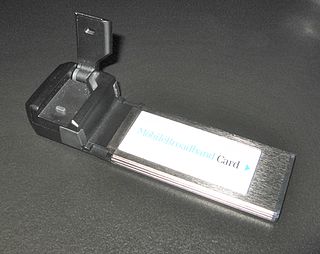The Universal Mobile Telecommunications System (UMTS) is a third generation mobile cellular system for networks based on the GSM standard. Developed and maintained by the 3GPP, UMTS is a component of the International Telecommunication Union IMT-2000 standard set and compares with the CDMA2000 standard set for networks based on the competing cdmaOne technology. UMTS uses wideband code-division multiple access (W-CDMA) radio access technology to offer greater spectral efficiency and bandwidth to mobile network operators.
In telecommunication, a public land mobile network (PLMN) is a combination of wireless communication services offered by a specific operator in a specific country. A PLMN typically consists of several cellular technologies like GSM/2G, UMTS/3G, LTE/4G, NR/5G, offered by a single operator within a given country, often referred to as a cellular network.

3G is the third generation of wireless mobile telecommunications technology. It is the upgrade to 2G, 2.5G, GPRS and 2.75G Enhanced Data Rates for GSM Evolution networks, offering faster data transfer, and better voice quality. This network was superseded by 4G, and later by 5G. This network is based on a set of standards used for mobile devices and mobile telecommunications services and networks that comply with the International Mobile Telecommunications-2000 (IMT-2000) specifications set by the International Telecommunication Union. 3G is used in wireless voice telephony, mobile Internet access, fixed wireless Internet access, video calls and mobile TV.

Worldwide Interoperability for Microwave Access (WiMAX) is a family of wireless broadband communication standards based on the IEEE 802.16 set of standards, which provide physical layer (PHY) and media access control (MAC) options.
4G is the fourth generation of broadband cellular network technology, succeeding 3G and preceding 5G. A 4G system must provide capabilities defined by ITU in IMT Advanced. Potential and current applications include amended mobile web access, IP telephony, gaming services, high-definition mobile TV, video conferencing, and 3D television.

Voice over wireless LAN (VoWLAN), also voice over Wi‑Fi (VoWiFi), is the use of a wireless broadband network according to the IEEE 802.11 standards for the purpose of vocal conversation. In essence, it is voice over IP (VoIP) over a Wi-Fi network. In most cases, the Wi-Fi network and voice components supporting the voice system are privately owned.
The IP Multimedia Subsystem or IP Multimedia Core Network Subsystem (IMS) is a standardised architectural framework for delivering IP multimedia services. Historically, mobile phones have provided voice call services over a circuit-switched-style network, rather than strictly over an IP packet-switched network. Various voice over IP technologies are available on smartphones; IMS provides a standard protocol across vendors.
The IEEE 802.21 refers to Media Independent Handoff (MIH) and is an IEEE standard published in 2008. The standard supports algorithms enabling seamless handover between wired and wireless networks of the same type as well as handover between different wired and wireless network types also called Media independent handover (MIH) or vertical handover. The vertical handover was first introduced by Mark Stemn and Randy Katz at U C Berkeley. The standard provides information to allow handing over to and from wired 802.3 networks to wireless 802.11, 802.15, 802.16, 3GPP and 3GPP2 networks through different handover mechanisms.
Mobile VoIP or simply mVoIP is an extension of mobility to a voice over IP network. Two types of communication are generally supported: cordless telephones using DECT or PCS protocols for short range or campus communications where all base stations are linked into the same LAN, and wider area communications using 3G or 4G protocols.

In telecommunications, a femtocell is a small, low-power cellular base station, typically designed for use in a home or small business. A broader term which is more widespread in the industry is small cell, with femtocell as a subset. It typically connects to the service provider's network via the Internet through a wired broadband link ; current designs typically support four to eight simultaneously active mobile phones in a residential setting depending on version number and femtocell hardware, and eight to sixteen mobile phones in enterprise settings. A femtocell allows service providers to extend service coverage indoors or at the cell edge, especially where access would otherwise be limited or unavailable. Although much attention is focused on WCDMA, the concept is applicable to all standards, including GSM, CDMA2000, TD-SCDMA, WiMAX and LTE solutions.
The GSM Interworking Profile, usually abbreviated to GIP and sometimes to IWP, is a profile for DECT that allows a DECT base station to form part of a GSM network, given suitable handsets. While proposed and tested, notably in Switzerland in 1995, the system has never been commercially deployed. Infrastructure issues make it less practical and useful to implement than the more recent GAN/UMA system, which can make use of usually unmetered and neutral Internet service to provide the connection back to the network operator.
A wide variety of different wireless data technologies exist, some in direct competition with one another, others designed for specific applications. Wireless technologies can be evaluated by a variety of different metrics of which some are described in this entry.

Mobile broadband is the marketing term for wireless Internet access via mobile networks. Access to the network can be made through a portable modem, wireless modem, or a tablet/smartphone or other mobile device. The first wireless Internet access became available in 1991 as part of the second generation (2G) of mobile phone technology. Higher speeds became available in 2001 and 2006 as part of the third (3G) and fourth (4G) generations. In 2011, 90% of the world's population lived in areas with 2G coverage, while 45% lived in areas with 2G and 3G coverage. Mobile broadband uses the spectrum of 225 MHz to 3700 MHz.
Media Independent Handover (MIH) is a standard being developed by IEEE 802.21 to enable the handover of IP sessions from one layer 2 access technology to another, to achieve mobility of end user devices (MIH).
The 3GPP has defined the Voice Call Continuity (VCC) specifications in order to describe how a voice call can be persisted, as a mobile phone moves between circuit switched and packet switched radio domains.
Dual-mode mobiles refer to mobile phones that are compatible with more than one form of data transmission or network.
Iristel is a Canadian provider of telecommunication services that is a competitive local exchange carrier (CLEC). The company was founded in 1999 and is headquartered in Markham, Ontario.

UMA Today is an international consortium of companies joined together to lead the adoption of 3GPP UMA technology around the world.
Mobile data offloading is the use of complementary network technologies for delivering data originally targeted for cellular networks. Offloading reduces the amount of data being carried on the cellular bands, freeing bandwidth for other users. It is also used in situations where local cell reception may be poor, allowing the user to connect via wired services with better connectivity.

Voice over LTE (VoLTE) is an LTE high-speed wireless communication standard for voice calls and SMS using mobile phones and data terminals. VoLTE has up to three times more voice and data capacity than older 3G UMTS and up to six times more than 2G GSM. It uses less bandwidth because VoLTE's packet headers are smaller than those of unoptimized VoIP/LTE. VoLTE calls are usually charged at the same rate as other calls.






